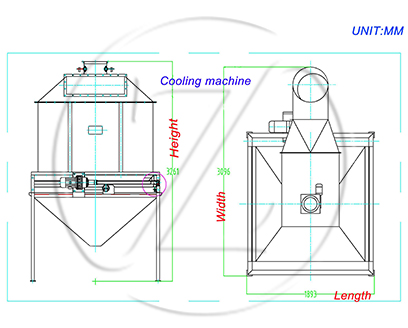- Zhengzhou City, Henan Province China
- Telephone: 0086-16637162658


⚪Customization&OEM
⚪ Tailored Solutions, Customized Plans.
⚪Install with precision and expertise.
⚪Support throughout and beyond.
Introduction of SKLN Counterflow Cooler:
SKLN feed pellet cooler is a crucial equipment for cooling and dehumidifying wet and hot pelletized feed after the pelletizing process.
The counterflow cooler can cool the pellets from a temperature of 70°C-90°C to slightly above room temperature (3°C-5°C) and reduce the moisture content to a safe level (≤12.5%), facilitating the transport and storage of the pellets.
Why Use SKLN Counterflow Cooler:
Pellets freshly pressed from the pelletizer have a temperature ranging from 60 to 90 degrees Celsius and a moisture content of approximately 14% to 15%. These pellets are soft, fragile, and prone to deterioration.
Cooling is necessary to reduce the final product's moisture content to between 10% and 13%. Lowering the temperature close to room temperature (3-5 degrees Celsius) ensures feed quality, reduces the risk of mold, extends storage life, and facilitates packaging and transportation.
Working Principle of SKLN Counterflow Cooler:
The SKLN counterflow cooler introduces newly prepared hot feed pellets into the equipment, allowing them to come into contact with the surrounding air.
During this process, the moisture within the feed pellets migrates towards the surface along tiny channels, and then the heat is evaporated from the pellets. Simultaneously, the air absorbing heat is heated, increasing its moisture-carrying capacity.
Finally, through a fan or exhaust system, the hot, moist air is expelled, achieving effective cooling of the feed and ensuring its quality and stabilit
Why choose a counterflow chiller from ZTIAS?
1, can uniformly cool all kinds of granular materials.
2、The overall layout and structure is compact and covers a small area.
3、The equipment is equipped with inspection door, observation window and top cover, which is convenient for maintenance.
4、Discharge pressure relief plate improves the working load and prolongs the life of the parts to ensure the durability of the equipment.
5、Gear motor drive eccentric shaft drive, equipment operation is stable and reliable.
SKLN countercurrent cooler parameters
|
Model |
Power(kW) |
Capacity(t/h) |
Power(kW) |
|
SKLN14×14 |
1.1 |
5 |
About>room temperature 5℃ |
|
SKLN17×17 |
1.1 |
7 |
About>room temperature 5℃ |
|
SKLN20×20 |
1.5 |
10 |
About>room temperature 5℃ |
|
SKLN24×24 |
1.5 |
15 |
About>room temperature 5℃ |
The production process of feed mill :
The Feed Milling Process typically involves the stages of raw material reception and storage, cleaning, crushing, dosing & mixing (batching), pelletizing, cooling, pellet refinement, screening & grading, packaging, and storage. In specific cases where clients have unique requirements for feed pellet production equipment, additional features such as liquid infusion, curing, spraying, extrusion, drying, and more may be integrated.

Do you know the production process of a feed manufacturing plant?
1.Raw material storage :
Given the diverse array of ingredients in animal feed, various types of silos are essential. The feed pellet production line can employ three types of silos, namely hopper silos, flat-bottom silos, and galvanized silos.

Primarily employed for eliminating impurities from feed raw materials, particularly large, medium, and ferrous impurities, aiming to achieve the following objectives:
○ Safeguarding both equipment and workers,○ Enhancing the quality of feed products, and ○ Ensuring secure and efficient equipment operation.
In accordance with the process flow and raw material composition of feed production, it is necessary to crush the raw materials to the required particle size.

4.Dosing equipment:
mainly used for dosing various raw materials, mixing materials evenly, including manual dosing type and automatic dosing type.
mix the feed ingredients thoroughly. This stage demands short blending cycles, high mixing quality, rapid discharge, low residue rates, excellent airtightness, and zero dust spillage.

6.Pellet Mill:
This process is to press out the pellets, the finished pellets are good palatability, storage resistance, there are two kinds of flat model and ring model, feed mills mainly use ring die pelletizing machine.

7.Cooling Equipment:
When pellets are extruded from the pellet machine, their moisture content reaches approximately 16%, and the temperature can reach 80-90 degrees Celsius. To facilitate pellet storage, the cooling process is indispensable.
8.Pellets Crusher / Breaker / Bucker :
Break the pellets into small particles.It is mainly used for chicken feed pellet line.
9.Screening Equipment:
After the pellet feed undergoes the crushing process, certain undesired materials such as powder are generated. This process primarily involves separating the non-conforming pellets and powder, allowing the qualified pellets to proceed to the next stage of production.
This includes both automatic packaging machines and manual packing machines.

11.Dust Removal Equipment:
Essential for eliminating dust and ensuring environmental protection.
12.Conveyor: for conveying feed ingredients, semi-finished and finished feeds
Get An Instant Quotation For all inquiries fill in the form below to send us a brief message,and we will get back to you as soon as possible.
Henan zhongzhenxing Machinery Equipment Co.,Ltd. Your dedicated partner in custom feed processing solutions. With a rich legacy spanning over a decade, we specialize in tailoring comprehensive equipment sets to meet the unique production needs of small, medium, and large-scale feed operations.